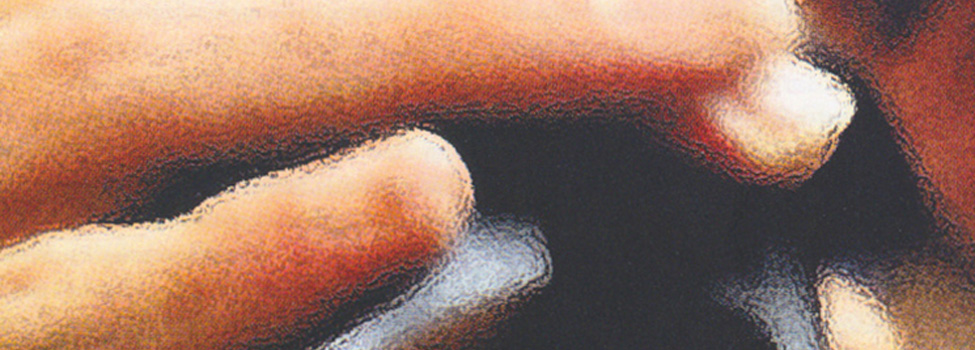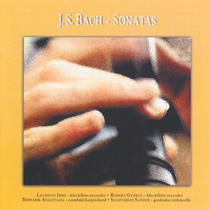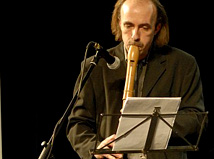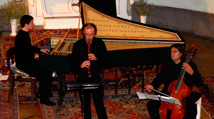Johann Sebastian Bach: Sonatas
Liner notes
Most of the chamber music of Johann Sebastian Bach (1685—1750) was written in the middle of the “instrumental” Cothen years, around 1720. The composer, who was in his thirties then, between 1717 and 1723 worked as a conductor in the little court of Prince Leopold in Alhalt, where he could concentrate on instrumental music. Besides a number of smaller compositions, the most important works of this period of over half a decade, between the Weimar and Leipzig years, are his three remained concertos for violin, the six sonatas for violin and harpsichord, the sonatas and partitas for violin solo, the three viola da gamba sonatas, the suites for violoncello solo, the four suites for orchestra, the six Brandenburg Concertos, the twice fifteen two-part and three-part inventions, the French and English suites, the Chromatic Fantasy and Fugue in D minor, and the first part of the Well-Tempered Clavier series. According to tradition, the sonatas for transverse flute, accompanied either by obligatory harpsichord or basso continuo were also written in this period. However, the dating and authenticity of some of the works provoked heated professional debates in the last two decades.
Among the wind instruments, the transverse flute was the last to take part in independent genres of music, although it was definitely quite popular on German land. For this reason it was sometimes called German flute, to be distinguished from the “straight” flute, namely the recorder, which was simply called “flauto” until 1750. For this latter kind of flute there were sonatas written by the French Jacques Paisible (about 1650—1721) in 1698, while the first sonatas for transverse flute appeared around 1715. They were composed by the German Johann Christian Schickard (about 1680—1762). The transverse flute’s star was rising quickly and by the middle of the 18th century it completely replaced the family of recorders, having been exclusive until then. The late baroque fashion of the transverse flute —as a lot of other fashions— started on its way from France. The court conductor of Louis XIV, Jean-Baptiste Lully began to employ the two kinds of flute of the same tuning in his orchestra. Yet the transverse flute soon acquired its own repertoire: the works of Michel de la Barre (about 1675—1743) written for transverse flute and basso continuo (0p. 4.) were published in Paris in 1703. Although these were not in sonata form, they were antecedents of the compositions of Bach written for flute two decades later.
As regards their genre, the flute sonatas, arranged three in a cycle in the Bach-catalogue, belong to two related types of form, similarly to the types of flute living together in that period. Among the concerto-type sonatas with three movements, accompanied by obligatory harpsichord (BWV1030—1032), only the first one, a composition originally written in G minor, later transposed in B minor, proved to be authentic and remained in its complete form. However, the sonatas with four movements for flute and continuo (BWV 1033—1035) follow the order of movements and formal traditions of the type “chiesa” or church sonatas.
Sonata in G minor (BWV 1020) (Transposed in A minor)
Research has undoubtedly proved that the sonata registered in the Bach-catalogue as a composition of the young Bach is not one of Johann Sebastian, but of Carl Phillip Emmanuel; all the contemporary sources indicate the latter as composer. The concerto-type sonata, which has three movements, was originally written for violin, but its range and facture made it suitable for being played on flute or recorder too. All this can explain not only the authencity but the time of the composition. It was the editorial practice typical of the generation after Bach that the composer did not exclude any performance by an alternative musical instrument in the interest of better saleability.
Sonata in E flat major (BWV 1031) (transp. in G major)
There are few such compositions in Bach’s life work whose composer and dating were at the same time refuted and asserted by arguments and evidences so contradictory like those of the popular Sonata for flute in E flat major. The composition, which also has a version in G major, is in its genre and form in relationship with the Sonata in G minor (BWV1020) that was for a long time wrongly attributed to J. S. Bach. Both sonatas belong to the concerto type, or rather they consist of fast, slow and fast movements. Moreover, the determination of the genre as concerto-sonata refers to the beginning of the pieces, where the two instruments appear with a contrast between tutti and solo, clearly separating from each other. In both compositions the two kinds of theme are closely connected with the related instrument. The middle movement is a solo accompanied by obligatory harpsichord in both sonatas, while the closing movement is a repeated allegro. In the opening movements the ritornello does not appear at the end of the movement for the last time, but at the place of the recapitulation, where there is no singing theme for solo instrument. Besides a number of musical similarities, there is a certain formal difference: instead of starting the ritornello part three times at the beginning of the movement, as we can see in the Sonata in E flat major, the Sonata in G minor starts the ritornello section only twice, while after the last ritornello it repeats not only the first one, but also the section after the second ritornello.
Sonata in E minor (BWV 1034) (transp. in G minor)
The Sonata in E minor for flute and its counterpart in major key are formally based on the usual order of movement in a sonata da chiesa: slow—fast—slow—fast. The Italian elements that can be observed in the melodic structure of both sonatas are combined with some elegance of expression: in the Sonata in E minor the two immoderately bright allegro movements coming after the Adagio introduction flank a majestic Andante movement based on ostinato bass. The Sonata in E major starts with an ingratiating cantilena. Its dynamic closing movement is preceded by two Italian-style movements: a characteristic Allegro in sonata form, as well as a concise Siciliano, which is at the same time of dancing and counterpoint character.
Sonata in E major (BWV 1035) (transp. in F major)
Visiting the Berlin court in 1741 and 1747, the elderly Bach presented the Prussian sovereign Frederick the Great —who had the reputation of being an excellent player of the flute— and his musician partner, Fredersdorf with three compositions of different genres for flute. The Trio sonata in C minor of the Musikalisches Opfer and the Sonata for flute in E major with continuo were written then. The two keys that are very inconvenient to play on contemporary flute make it possible that both compositions were written for the type of flute used in the Berlin court, namely for the flauto d’amore, which was a third-transposing member of French origin of the family of flutes containing four or five instruments in the middle of the 18th century. Transposing was not too difficult for the player, since he only had to read his part according to French violin clef. The fact that this type of flute sonatas with harpsichord accompaniment, probably to prevent German musicians from having to read the French violin clef so unusual for them.
Trio sonata in G major for two flutes and figured bass (BWV 1039) (transp. in B flat major)
The two Adagio movements of the trio sonata, also written after the model of church sonatas, are followed by an allegro with fairly moderate tempo and a closing Presto. The opening adagio with 12/8 pulse belongs to the same Siciliano type of Italian character as the first movement of the Sonata for violin and harpsichord in C minor (BWV 1017) or the Aria in B minor with obligatory violin in the St. Matthew’s Passion.
The Trio sonata in G major for two flutes and continuo written around 1720 has two more versions. One of them is a Sonata for viola da gamba accompanied by obligatory harpsichord (BWV 1027); while its closing movement is a transcription for organ (BWV 1027/a). In the gamba version Bach wrote the first flute’s part for the right hand of the harpsichord player and the bass for the left hand. The second flute was played by the gamba, transposed an octave lower.




